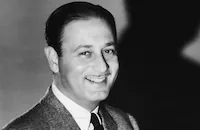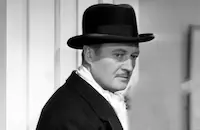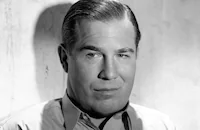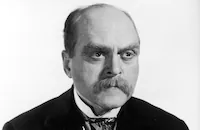The Garden Murder Case

Brief Synopsis
Cast & Crew
Edwin L. Marin
Edmund Lowe
Virginia Bruce
Benita Hume
Douglas Walton
Nat Pendleton
Film Details
Technical Specs

Synopsis
At a steeplechase race for amateur "gentlemen" riders, millionaire Lowe Hammle is having a party in his box. Floyd Garden, a friend of Hammle, who has been having an affair with Madge Fenwicke-Ralston, a houseguest and wife of the much older Major Fenwicke-Ralston, is scheduled to ride Hammle's horse. Because Floyd seems depressed, Madge asks him not to ride, but he only answers that he will ride and he will break his neck. On the last jump of the race, Floyd falls to his death. Though suicide is suspected, Philo Vance, a detective who is in Hammle's box, decides to investigate Floyd's death. That night, at a party at Hammle's, Hammle's neice, Zalia Graem, who is his ward but hates him, says that she thinks Hammle is responsible for Floyd's death. At the same time, Hammle's mother's nurse, English-born Gladys Beeton, with whom Hammle has been conducting an affair, threatens him with a breach-of-promise suit. Hammle's mother, meanwhile, is plotting with him to breakup Zalia's relationship with Woode Swift, a young man with whom she is in love. To accomplish the breakup, Hammle offers Swift a lucrative job in a Latin American country, but when Zalia finds out, she is angry at Woode for accepting the job and at her uncle for offering it. Later that night, a shot is heard, and Hammle's body is found dead in the library. Suicide is again suspected, but Vance is certain that it is murder because there are no powder burns on Hammle's clothes and he was apparently shot with an antique dueling pistol. The police agree, and Vance theorizes that the murderer was a woman who was unfamiliar with guns. When all of the women suspects are questioned, each say that they heard the major's voice coming from the library just before the shot, but the major was with Woode in the billiard room all night. Because Zalia hated Hammle and is the principal beneficiary of his estate, the police suspect her, but Vance believes that she is innocent. The next day, Madge telephones Vance and says that she knows who killed Hammle. Because Vance is concerned that someone is listening in on the line, he asks her to meet him at the district attorney's office. Before Madge leaves the house, the major has a few words with her, after which she blankly tells the maid that she is going to be killed. Zalia then follows Madge, and sees her plunge from the top of a double-decker bus. When the police are summoned, they accuse Zalia of Madge's murder, and she admits to listening in on the phone call to Vance. Though the police want to arrest her, Vance convinces them to let him be responsible for her. He then learns from her that Hammle had once been a ventriloquist. When he also learns that just prior to his death Hammle had called the immigration department to have Mrs. Beeton departed, he summizes that Hammle had immitated the major's voice to do so. Vance concludes that, because of the disguised voice, it was the major, not Hammle who was the intended victim. On the way to the police station, Vance and Zalia stop in a museum and, inspired by a discussion of the hypnotic power over pythons, Vance suddenly deduces that the major hypnotized Garden because of Madge's affair; Madge had then attempted to kill the major, but had mistakenly killed Hammle; and, the major then hypnotized Madge to jump to her death. Vance returns to the house and pretends to allow the major to hypnotize him, after which the major lures Vance to a ledge. Vance then "awakens," and the police, who had been summoned by Zalia, shoot the major, who plunges to his death.

Director

Edwin L. Marin
Cast

Edmund Lowe

Virginia Bruce

Benita Hume

Douglas Walton

Nat Pendleton

Gene Lockhart

H. B. Warner

Kent Smith

Grant Mitchell

Frieda Inescort

Henry B. Walthall

Jessie Ralph
Charles Trowbridge

Etienne Girardot

Rosalind Ivan
Fred Warren
William Austin
Duke York
Fred Kelsey
Wilbur Mack
Crew
Dr. William Axt
Charles [g.] Clarke
Cedric Gibbons
Lucien Hubbard
Ben Lewis
Ned Marin
Bertram Millhauser
Les Selander
Douglas Shearer
Dolly Tree
Edwin B. Willis
Joseph Wright

Film Details
Technical Specs

Articles
The Garden Murder Case
By Richard Harland Smith

The Garden Murder Case
Quotes
Trivia
Notes
According to various news items in Hollywood Reporter, Brian Aherne and Rosalind Russell were originally considered for the leads, and the race track sequence of the film was shot at Santa Anita. Hollywood Reporter production charts include Rosalind Ivan, Robert McWade, Olaf Hytten and Leonard Carey in the cast, however, their appearances in the completed film have not been confirmed. A news item in Hollywood Reporter noted that Ivan, a London stage actress, was to have made her debut in the film. For information on other films in which the detective Philo Vance appeared, see the entry below for The Kennel Murder Case and consult the Series Index.















